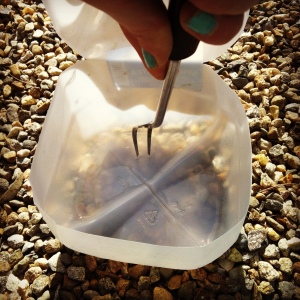View the original post at A Life Enchanted
It’s been raining for days here in the Shire. But you won’t hear me complain. I love the rain. I find just as much beauty in a warm Spring rain as I do those bright sunny days. And I’m not afraid to get a little…or a lot wet for a visit to the garden.
I’m also not going to complain, because as you may have noticed, I have been rather preoccupied as of late. I know, I know. I haven’t written in days. I have been so busy with products though that there hasn’t been time for much of anything. I can’t tell you all the details for I don’t want to ruin any surprises for some, but I have been in a creating frenzy. My house has been littered with bottles and jars, paper drying and masses of heavenly herbs. There have been early mornings, long days and late nights. I am proud to say I have created more potions and brews in the past week than ever before!
And my gardens can prove it. Oh, the neglect! I dodged a few rain drops and took some photos. You will see just what has been … NOT happening or happening without me here in the Enchanted Gardens. They sure aren’t looking very enchanted today. Have a look….
There’s quite a bit of lettuce.
But so much more waiting for a home.
Some celery, scallion and a lonely leek patiently waiting for the others to join.
The watermelon radish are putting up a good fight against the stones.
How do they get there?
The peas are looking okay.
I do wish I had gotten them in a week or two earlier.
The blackberries need a straw blanket…
and perhaps a trim.
They chose this spot themselves. We didn’t plant them.
I do wish they had chosen a spot further from the raised beds.
Another bed and a fence belong here.
But I just don’t have the heart to pull them out.
Nor do I have the heart to remove these
that have created a home on the other side of the raised beds.
Look at that mess!
TOO many beets?
They self seeded AND I unknowingly planted more.
Thinning is in order here.
And here.
The cilantro self seeded last year
here where the pattypan squash will call home this year.
And the dill called this place home
but the cucumbers are moving in soon.
Look at all that baby dill!
And I planted more…. uh oh.
I was sad to tear out this raised bed,
but the hot tub needs a home too.
I told you it was a busy week…
The herb garden needs some love!
And some mulch.
But the chives are happy.
The oregano is happy too.
She just needs a little hair cut.
So do her sisters.
The strawberry patch is doing okay,
but look what happens to the seaweed with all this rain.
Soft and mushy and slimy.
This is why I don’t use it for full mulching.
This is Matilda.
She was supposed to be a dwarf weeping cherry.
She is not a dwarf.
I love her dearly, even if she is far too close to the house for her size.
The lawn is in terrible shape this year.
Ants and moles have taken up residence.
Sixx, the stealthy hunter is taking care of the moles.
The ants… well, that’s my job.
And I’m slacking.
The dogs have done their fair share of destruction as well.
I have my work cut out for me.
Nothing has been edged
and the mustard greens are trying to over take the lawn.
 But The Mister’s grandmothers peonies are loving their new home.
But The Mister’s grandmothers peonies are loving their new home.
Their very healthy, vibrant sisters didn’t fair so well.
Who new the gas man would decide the tank should be moved
when only come to fill??
And who in their right mind would place it over a group
of glorious peonies 3 feet wide?
Well, he did. And he killed them.
All of them.
This group here is the last of them because, well…
The Mister’s mum and aunts…
They killed theirs too.
I’m taking dear care of these ones.
Grow little beauties. Grow!
So the legacy may live on.
This is where my iPhone risked serious destruction as the drops turned to streams. The sun is finally shining though, and the last of the mass of botanicals is to be delivered today. Until Monday of course, when the conjuring will begin again.






















































